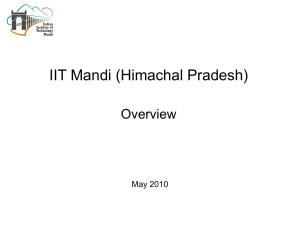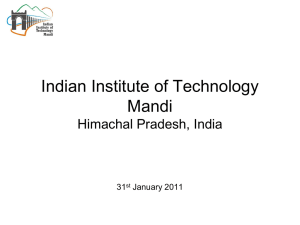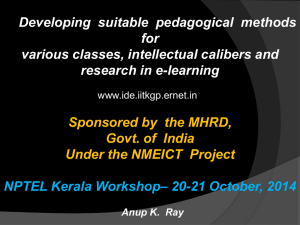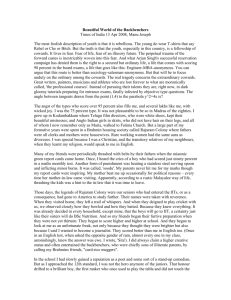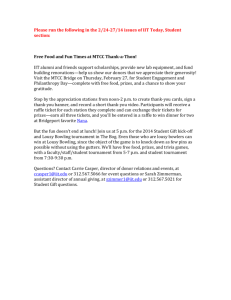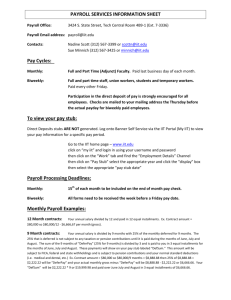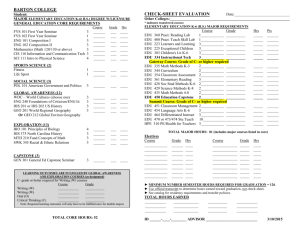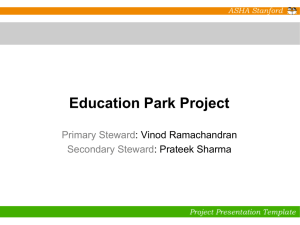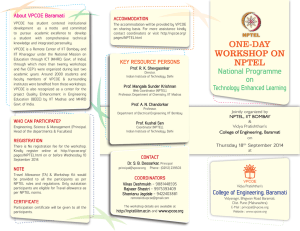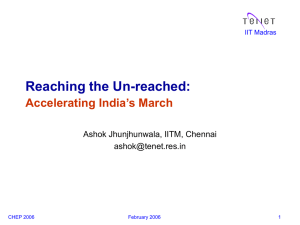national programme on technology enhanced learning (nptel)
advertisement
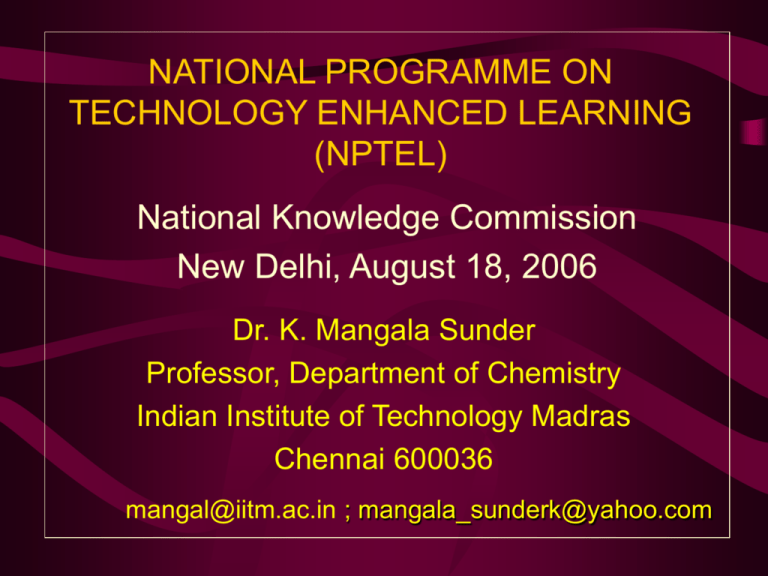
NATIONAL PROGRAMME ON TECHNOLOGY ENHANCED LEARNING (NPTEL) National Knowledge Commission New Delhi, August 18, 2006 Dr. K. Mangala Sunder Professor, Department of Chemistry Indian Institute of Technology Madras Chennai 600036 mangal@iitm.ac.in ; mangala_sunderk@yahoo.com Devise and guide reforms that will transform India into a strong and vibrant knowledge economy in coming years Focus areas of interest for the project in several phases Higher Education: Professional Education Distance Education Continuous Learning Objectives (in 2003) • 100 Web based Courses– Supplements • 100 Video Courses (40 hours duration for each course) in five major branches of engineering at the undergraduate level. Deliverables (in 2006) • 120 Web based Courses– Supplements • 115 Video Courses in core sciences, Civil, Computer Science, electrical, electronics and mechanical engineering (40-50 hours duration for each course) DISTANCE EDUCATION Clear and easily documented need: 450000 seats; 35000 reasonable ones; demand increasing exponentially! India has no choice: even to maintain the current levels a new major university needed every week! Massive online education is an important emerging market and therefore a business opportunity. NPTEL – AN OPPORTUNITY • Technology already available and will only improve. Communications band-width and computer power per unit cost will continue to increase • NPTEL offers an opportunity to provide reach as well as exciting improvement in quality NPTEL’s PREMISES • Today's students prefer to plunge in and learn through participation and experimentation in a media-rich environment • Faculty members should become facilitators and designers of learning experiences, processes, and environments • Intelligent software agents that can browse far and wide through robust knowledge networks effortlessly may replace specialists. • Role of the library will be more that of a knowledge navigator, a facilitator of retrieval and dissemination Details of the Programme Courses by discipline Core Sciences Web (14) Video (16) Civil Engineering Web (27) Video (22) Comp. Sc. and Engg. Web (18) Video (19) Electrical Engineering Web (18) Video (18) Electronics and Comm. Engg. Mechanical Engg. Web (20) Video (19) Web (23) Video (21) Total 120 115 Courses by Institute IIT Bombay Web (17) Video (13) IIT Delhi Web (12) Video (18) IIT Guwahati Web (15) Video (6) IIT Kanpur Web (14) Video (19) IIT Kharagpur Web (19) Video (18) IIT Madras Web (19) Video (20) IIT Roorkee Web (7) Video (13) IISc Bangalore Web (17) Video (8) Total Web (120) Video (115) ORGANIZATIONAL ISSUES • Design Team made up of the IITs/IISc • Organization Synergy - more than just a division of labor between eight institutions • Continued support from Government • Long-range effectiveness will depend on the strength of the relationship between the IITs and the user organizations Creation of a hierarchy of faculty for Implementation National Programme Committee Programme Implementation Committee TEL Coord IITB TEL Coord IITD Contents Review Committee TEL Coord IITG Core courses TEL Coord IITKgp Civil Engg TEL Coord IITK Comp. Sci. & Engg TEL TEL Coord Coord IITM IITR Elec. Engg E&C Engg Faculty coordinators for each course from Partner Institutions and Associate Partner Institutions TEL Coord IISc Mech Engg DESIGN ISSUES – Target audience: initially professors in the user institutions; finally students – Selecting and building the courses around the demand in user organizations – Modules as units of change in education - flexibility – Role of exams in creating value for the user organizations – All the modules developed to be used in IITs for teaching the courses. Other Institutions can use the relevant ones for every course. IMPLEMENTATION ISSUES – Large number vs smaller number of courses of a higher quality in the first year – A mix of standard lecture videos and more innovative interventions – Incentives to generate, to re-calibrate the materials, to remove poor materials – Getting the college Principals on board increases to help introduce changes in the system. Web Courses --Objectives Summary of the programme for web supplements • Localization of examples • Elaboration of key concepts and theorems to facilitate clearer understanding • Case studies to provide more comprehensive design experience • Examples that require the use of different categories of engineering knowledge under different sets of assumptions. • Question banks to assist instructors to design good test and examinations • Additional reading material for underperforming students, especially those with difficulties with English. • Additional reading material for over-achievers • Historical information and anecdotes related to specific topics • Creation of the e-learning material in those formats which ensure that the content creation and course management platforms are decoupled. • Simple course management packages that provide features like e-mail queries by students, bulletin board and frequently Asked Questions (FAQ). • Many modules are being prepared preferably by a team of faculty. • The material will be suitably organized to create CDs to meet the needs of students of different universities. • The same material can be suitably restructured for printing. Video Courses --Objectives The programme for video lectures: The course will consist of around 40 video lectures. Each video lecture will be of one hour duration To enhance the longevity of the video lectures. Video lectures are confined to core concepts. Its contents are distinct from text book and web support material Video Courses --Objectives • The video lectures utilize the facilities of the video medium and are expected to contain interactions with professionals from industry as appropriate. • The lectures will emphasize the relations of theory to industrial practice as appropriate • Creation of video lecture units is not tied with the scheduling of regular courses in the Institution. Deployment and follow-up Services The following possibilities are being examined regarding dissemination of web content: • Host the e-content on a web site that students can log on to. • E-contents be made available in the form of CDs. • Colleges be encouraged to host these materials on one of their servers and allow students to access. • E-content converted into print form and then distributed at a low cost. • Navigational flexibility of e-material, not possible in print format. Several workshops in IIT Madras, IIT Kharagpur, IISc Bangalore and IIT Bombay. Review of E-support material by various faculty outside of the PIs in progress. Generation of E-Support Material for the video: All the courses to be broadcast through Eklavya, or, are in the queue for broadcast in the coming months • Course syllabi drafted for every course based on AICTE model curriculum • Syllabi adopted by major affiliating Universities such as Anna University, Tamil Nadu, Jawaharlal Nehru Technical University, Andhra Pradesh and Viswesvaraiah Technical University, Karnataka. • The total number of faculty involved in content creation is well over 300 from all IITs and IISc. • Syllabi posted in the NPTEL website in detail—module-wise and/or lecture-wise wherever provided by the faculty. IIT Madras, IIT Bombay and IIT Kharagpur working together in the development of a standard internet template for hosting web contents NPTEL WebSite available for updating the contents at IIT Madras, the Coordinating Institute. The site address : http://nptel.iitm.ac.in Deployment/Transmission of video courses • Current transmission is through Eklavya Channel which footprints all of India • Several institutions have antenna to receive Eklavya • Individual users access through cable • MHRD to work with Prasar Bharati to carry this channel on the DTH ASSESSMENT • Specifying levels of analysis (i.e., program/ target level/ specific course level/ module level within a course) • Articulating outcomes early in the design process • Spelling out clearly the kind of skills students are expected to acquire and be able to demonstrate • factoring in time when specifying outcomes ASSESSMENT AND DESIGN • Stating overall objectives in an operational way • highly interdependent activities • assessment criteria should precede design • iterative process of doing assessment and redesigning assessment IIT Madras Infrastructure as a coordinating institute and its own web course content creation programme Integrate the institute facilities--software, hardware, human resource and training for the new technology into one walk-in centre for faculty and students. Web and video Studio Centre for Continuing Education. Facilities-Hardware • 50 Pentiums and 10 Macs running several operating systems—Windows, Linux, Solaris, Mac OS X. • Digital scanners, high quality laser color printers • A number of low and medium end servers • Two fully integrated video recording studios • A non-linear video editing studio with the movie editing capabilities Facilities-Hardware • SunFire 15K Enterpise Server with complete Sun Microsystems software package (Solaris 9/10) • Storage Rack (4 TB) • Apple X Serve for QuickTime streaming (Proposed hardware) • Electronic classroom with 100 nodes (proposed facility) Software • Web design, content creation, dynamic and static, interactive: Macromedia Suite (Dreamweaver, Flash, Authorware, Director, Freehand and Fireworks) • Adobe suite and Acrobat Writer • MSDN on site license • Mathtype, Tex for windows • Any other as proposed by faculty from time to time. • Corel (Draw, word perfect) • 3D Studio Max • 3D Maya (currently being added) Human Resource • Current -- 25 project associates/ assistants/technicians/ attendants • (qualifications: M. C. A., M. Sc., B. E. /B. Tech., M. B. A.) • In-house development of software skills. • Work with individual faculty. Sun Server for e-learning and digital library 1. Sun Server for e-learning and digital library 2. Thank you
